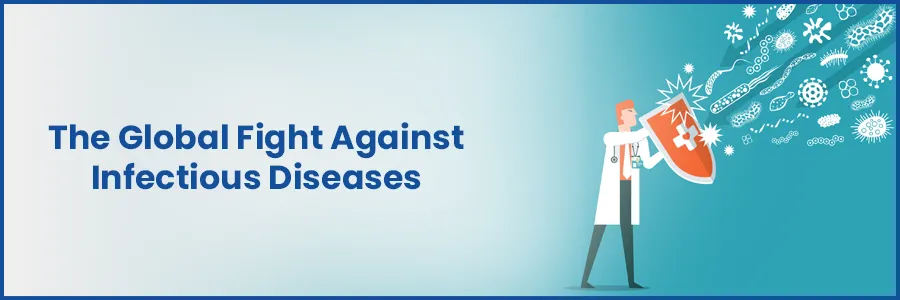The Global Fight Against Infectious Diseases

Infectious diseases, characterized by their ability to spread from person to person, have been a persistent challenge throughout human history. As our world becomes increasingly interconnected, the threat posed by these diseases transcends borders and necessitates a coordinated global response. This article explores the multifaceted nature of the worldwide fight against infectious diseases, delving into historical lessons, the current landscape, collaborative efforts, challenges, and the road ahead.
Historical Context: Learning from the Past
History has witnessed several infectious disease outbreaks that have left a lasting impact on societies and health systems. The Spanish flu pandemic of 1918 and the emergence of HIV/AIDS in the 1980s serve as poignant reminders of the importance of timely intervention, scientific research, and international cooperation in mitigating the spread of infectious diseases.
Current Landscape of Infectious Diseases: A Global Challenge
Today, infectious diseases continue to pose a significant threat to both public health and economies worldwide. Malaria, tuberculosis, HIV/AIDS, and emerging pathogens like dengue fever and Ebola persistently challenge our healthcare systems. The burden of these diseases falls disproportionately on low- and middle-income countries, highlighting the urgent need for equitable healthcare access and a united global response.
Factors Contributing to Global Spread: Understanding the Dynamics
Various factors contribute to the global spread of infectious diseases. Rapid urbanization, increased international travel and trade, shifting climate patterns, and the rise of antimicrobial resistance create an environment conducive to the propagation of pathogens. Addressing these interconnected factors requires collaborative efforts that span geographical boundaries.
Global Efforts and Initiatives: Uniting for a Healthier Future
The World Health Organization (WHO) coordinates global responses to infectious disease threats. Collaborative partnerships between countries, organizations, and researchers have led to advancements in disease surveillance, research, and prevention strategies. Adequate funding and resource allocation underscores the recognition of the significance of infectious diseases on a global scale.
Case Studies: Insights from Battles Against Infectious Diseases
Examining specific outbreaks provides valuable insights into the challenges and successes of global disease management efforts
Ebola Outbreak in West Africa: Lessons in Swift Response
The devastating Ebola outbreak underscored the importance of rapid response mechanisms and international aid. The global community rallied to provide medical personnel, resources, and expertise to contain the outbreak and prevent its spread.
Zika Virus Epidemic: A Nexus of Climate and Health
The Zika virus epidemic highlighted the intricate relationship between vector-borne diseases, climate change, and global health. This interconnectedness emphasized the need for adaptable strategies for evolving disease dynamics.
COVID-19 Pandemic: An Unprecedented Challenge
The ongoing COVID-19 pandemic laid bare vulnerabilities in healthcare systems worldwide. The pandemic demonstrated the critical role of research, timely communication, and international cooperation in managing and mitigating the impact of a novel pathogen.
Strategies for Prevention and Control: Equipping Ourselves
Efforts to prevent and control infectious diseases rely on a combination of strategies:
Vaccination Programs: A Cornerstone of Prevention
Vaccines are among the most effective tools in preventing infectious diseases. The global success stories of diseases like smallpox highlight the impact of vaccination campaigns in disease eradication.
Surveillance and Early Response: Nipping Outbreaks in the Bud
Effective disease monitoring and surveillance systems enable rapid response to potential outbreaks. Timely alerts and preparedness measures are crucial in curtailing the spread of infections.
Health Education and Community Engagement: Empowering the Public
Raising awareness about disease transmission, prevention, and proper hygiene practices is paramount. Empowering communities to participate in disease prevention actively fosters a sense of ownership in maintaining public health.
Quarantine and Isolation Measures: Balancing Public Health and Individual Rights
During outbreaks, quarantine and isolation measures play a critical role in preventing the spread of disease. Striking a balance between safeguarding public health and respecting individual rights is a delicate challenge.
Challenges in the Global Fight: Navigating Complexities
While global efforts have made significant progress, challenges persist:
Socioeconomic Disparities: Addressing Health Inequities
Unequal access to healthcare exacerbates the impact of infectious diseases, particularly in resource-limited settings. Achieving health equity requires comprehensive strategies that address systemic disparities.
Misinformation and Vaccine Hesitancy: Battling the Spread of Fear
Misinformation and vaccine hesitancy undermine efforts to control diseases. Effective science communication, public education, and building trust in healthcare systems are crucial to combat misinformation.
Political and Cooperation Barriers: Uniting for Collective Action
Political tensions and lack of international cooperation can hinder effective responses to global health crises. Overcoming these challenges requires diplomacy and a shared commitment to global health security.
Technological Innovations in Disease Management: Harnessing Science
Innovations in disease management are transforming the way we combat infections:
Advanced Diagnostics: Swift and Accurate Identification
Rapid testing and molecular diagnostics enable early detection of pathogens, aiding in prompt treatment and containment efforts.
Genomic Research: Unlocking Pathogen Secrets
Genomic research provides valuable insights into the genetic makeup of pathogens. This knowledge informs the development of targeted interventions, such as vaccines and treatments.
Telemedicine and Digital Solutions: Revolutionizing Healthcare Delivery
Telemedicine and digital health solutions offer avenues for remote healthcare delivery and real-time monitoring. These innovations are especially critical in reaching underserved populations.
Future Outlook: Fortifying Global Health
The path forward demands a forward-looking approach:
Remaining Vigilant Against New Pandemics
The potential for new pandemics underscores the need for ongoing vigilance and preparedness. Rapid response and adaptive strategies are essential in containing emerging threats.
Investing in Research and Preparedness
Sustained investment in research capabilities and healthcare infrastructure is crucial. Preparing for future challenges requires continuous innovation and collaboration.
Strengthening International Collaboration
Global health security relies on collective action. Collaborative efforts, information sharing, and resource allocation remain pivotal in safeguarding global well-being.
Conclusion:
In the ongoing battle against infectious diseases, a united front is indispensable. We can build a resilient global health ecosystem by learning from history, embracing innovation, and fostering international cooperation. Each individual, community, nation, and organization contribute to this shared responsibility. Together, we can overcome challenges, prevent outbreaks, and ensure a healthier and safer world for future generations.